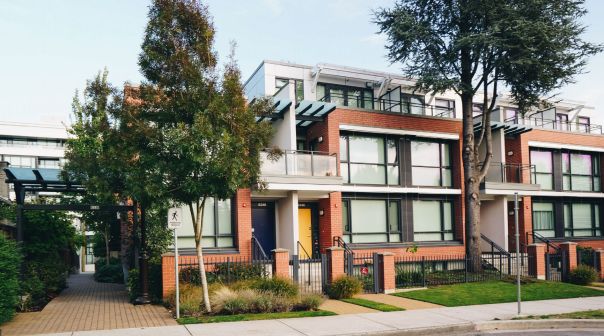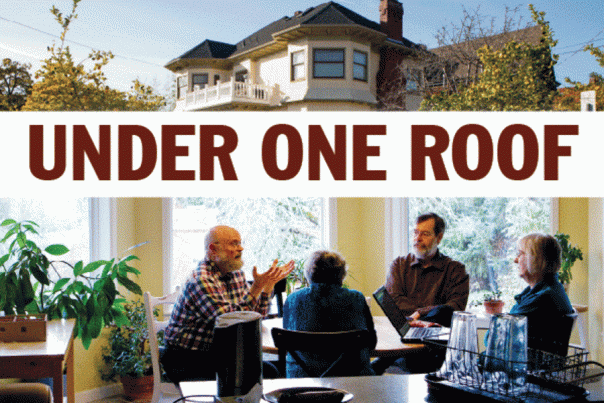
by Guy Dauncey
What does it mean to be so worried, because you really can’t afford the rent? To have to surrender your hope of ever owning a home? To face the end of a rental lease and know that there is NOTHING out there that you can afford? To stare homelessness in the face?
Many of us are comfortably housed, but many are not. The autumn rains have arrived, and the harvest crops are being gathered in. Everyone seems to be getting on with their lives. And yet for many people, the smiles and kindnesses that make life worth living mask a level of stress and worry that should have no place in our community.
How can there be such a housing crisis?
How can it be that in this Cowichan Valley that we love so much, there is such a housing crisis? How can democracy, the housing market, and local government have failed us so completely?
The reasons are many, but what matters now in Shawnigan and Mill Bay, Cobble Hill and Duncan, Youbou and Cowichan Lake, Crofton and Chemainus, Saltair and Ladysmith, is what we can do about it. For a Permanent, 100-year Solution, see here.
The Cowichan Housing Association estimates that the CVRD needs 1,600 new affordable homes, 750 for people earning less than $19,000 a year and 850 for people earning less than $45,000. With the added pressure from people arriving from the Lower Mainland, their bulging pockets pushing up prices and rents, we probably need 2,000 new affordable homes.
October 20th – A Critical Vote
And here’s the thing. On October 20th, if we vote YES in the Affordable Housing Referendum (listed on the ballot as the Cowichan Housing Association Annual Financial Contribution Service), we can begin to make this happen. Voting YES will add just $20 a year to the annual property tax on an average house worth $500,000.
The resulting income of $765,000 a year will enable the Cowichan Housing Association (CHA) to invest $500,000 a year as seed funding to build homes for low to moderate income households, leveraging as much as $15 million in provincial and federal money, while providing $138,000 a year for the project planning that will be needed and $127,000 for administration and other overheads.
I know there are some who feel they can’t afford the $20, or that it’s not the CVRD’s responsibility to do this. The province and the feds are putting money on the table for affordable housing, but we need a strong voice locally to develop projects and form the partnerships to make them happen. If you are stretched financially, and over 55, you can defer your municipal taxes. People are hurting. We really need this. Please vote yes.
Two Thousand New Affordable Homes
So how could 2,000 new affordable homes be created over the next five years? Here’s one possible plan.
Ten Strategies |
Total | 2019 | 2020 | 2021 | 2022 | 2023 |
| 1. New secondary suites | 250 | 50 | 50 | 50 | 50 | 50 |
| 2. 15% of units in developers’ projects to be affordable | 120 | 20 | 25 | 25 | 25 | 25 |
| 3. Rezone Single-Family neighbourhoods for townhouses | 250 | 0 | 50 | 100 | 50 | 50 |
| 4. New student housing | 100 | 0 | 0 | 50 | 50 | 0 |
| 5. Housing First projects for homeless | 130 | 10 | 30 | 30 | 40 | 20 |
| 6. Cowichan Housing Association | 400 | 0 | 100 | 100 | 100 | 100 |
| 7. Housing Cooperatives, 10 coops x 25 | 250 | 0 | 50 | 50 | 100 | 50 |
| 8. Shared living homes, 5 people each | 250 | 50 | 50 | 50 | 50 | 50 |
| 9. Tiny Homes Villages, 10 x 20 homes | 200 | 0 | 40 | 60 | 60 | 40 |
| 10. Farm Villages, 5 villages, 10 homes | 50 | 0 | 10 | 20 | 10 | 10 |
| 2000 | 130 | 405 | 535 | 535 | 395 |
1. Secondary Suites
Allow secondary suites, garden suites and carriage houses everywhere. Do as Victoria has done, and radically simplify the regulatory process. Waive all the fees and additional municipal taxes if someone commits to create and rent an affordable suite for ten years. Produce a brochure listing local architects and builders who are willing to help. If fifty new suites are built each year, that’s 250 new affordable homes.

2. Make 15% of all New Development Projects Affordable
If the CVRD and municipalities were to require that 15% or 25% of new homes in developments of ten units or more were affordable rental units, this could become a permanent source of new affordable housing. It’s called Inclusionary Zoning, and if developers work in partnership with the CHA, over five years it could hopefully yield 120 new affordable homes.

3. Rezone Single-Family Neighbourhoods to Allow Townhouses
A healthy urban centre needs a mix of single-family dwellings, apartments and townhouses. In the CVRD, we are really unbalanced. More than 90% of our housing is single family, which is the most expensive to build. By selectively rezoning neighbourhoods close to urban centres to allow three-storey townhouses, while respecting each neighbourhood’s character and retaining tree canopies, we can open up a space for redevelopment which will include affordable housing. Over five years, this could create 250 new homes.

4. Build New Student Housing
Every student at the VIU Cowichan Campus in Duncan needs an affordable home, and student housing is the cheapest to build at around $100,00 a unit. 100 new units would free up 100 spaces where students are currently living.

5. Housing First for Homeless People
In last August’s CVRD Homeless Count 89 people were living on the streets, in the woods and under the bushes; there are probably more. The solution is called Housing First, which puts creating a home first, and then addressing people’s mental health and addiction needs. It’s also cheaper, costing up to $22,000 a year, compared to $29,000 to $53,000 for health, legal and emergency housing for someone who is homeless. This could contribute 130 units towards our goal.

6. Affordable Housing Projects
If we vote YES, the Cowichan Housing Association will be able to leverage federal and provincial money to form partnerships to build targeted affordable housing projects. If we allow a year for planning, and if the CHA can create 100 units a year, this could add 400 affordable homes over five years.

7. Housing Cooperatives
In Sweden, 13,000 housing cooperatives own almost a million dwellings, providing housing for 22% of Sweden’s people. The tenant-owners finance most of the development costs, and the rest is raised through loans from financial institutions. Maybe zero-interest capital loans could be possible, in partnership with CMHC or the federal or provincial government. It just needs training for would-be coop organizers to help them buy the land, do the planning, file a zoning application, and win approval to build the projects. If ten new housing coops can be built with 25 units each, this would contribute 250 new units.

8. Shared Homes
When I lived in London, England, four of us bought a house together as ‘tenants in common’, where we lived cooperatively. It’s easily done, once you know it’s possible, and how the future sale to a new partner works. With a little bit of training, friends could form groups and buy a house together. If ten groups of five people did this each year, over five years this could add 250 units of affordable housing.

9. Tiny Homes Villages
For some people, a tiny home is half of what they want. A small village of tiny homes, bringing peaceful days with friends and family, shared gardening and rural quiet, is 100% of what they want. And surely, it’s possible. It just needs training to develop the know-how for financing, zoning, water, sewage, building code, and so on. If we could help 200 people to build ten small villages, that’s 200 units to add to our total.

10. Farm Villages
Other people want to live in small homes, but they also want to farm. If zoning could be sought and achieved to build small clustered farm villages, with conditions attached ensuring that only people working on the land could live there, more food could be grown and young farmers could see their dreams fulfilled. If 5 Farm Villages could be created with 10 homes in each, that’s another 50 units towards the goal.

Vote YES on October 20th. Please.
It’s all possible if we put our minds to it. Let’s use this crisis creatively. Vote YES on October 20th. Please.
* If you are not on the list of registered voters, you can register at the time of voting. Just bring two pieces of ID. Members of First Nations living on Reserve Land can also vote.
First published in Valley Voice, October 2018.
Guy Dauncey is the author of ten books, including the novel Journey to the Future: A Better World is Possible, set in the year 2032. He lives in Yellow Point. He is an Honorary Member of the Planning Institute of BC.


Excellent article, Guy, which a friend forwarded to me. I’m one of those effected having enjoyed wonderful, affordable hsg. for over 16 yrs. Then, because the owner decided to use the suite differently, was dropped into the current market last yr. After finding what I thought was my last long term rental and living in its incomplete condition for 4 mos., the owners decided they couldn’t finish it as long as I was living there so I’ve gone thro’ it a second time in 6 mos. Now, because of issues in my current suite and difficult owners, I’m still looking. I dream of winning the Lotto so I can again buy a home.
Keep up all your good work that’s researched and written so well, Ellie
LikeLike
Many thanks, Ellie. I do hope you find somewhere!
LikeLike
Some great, practical ideas, the group experience is interesting although there is a lot to consider in that proposal.
LikeLike
Perfect timing to provide solutions for candidates seeking to represent us as decision makers. I will definitely make sure they get a copy of this. Many very workable ideas. Thanks for putting this together. Barbara VanSickle, Vernon
LikeLike
Thanks!
LikeLike
Great ideas and certainly achievable.
LikeLike
Are you registered with elections BC as a third party advertiser?
LikeLike
Yes, I am!
LikeLike
Great article Guy and thank-you for putting a real world perspective on what can actually be accomplished here in the Cowichan Valley.
LikeLike
Hello, Thanks for this article. I too live in Yellow Point and am wondering if there is anything in the works for tiny home villages here in our area?
I would be most interested in creating a tiny home village on my property. Any information you might be able to share or links to more information on this for Yellow Point and area would be most helpful.
LikeLike
Hi J., I’ve not gotten wind of anything. However, there will be a public meeting about the development of a new Official Community Plan for Area H of the CVRD on February 8th, at North Oyster Hall, and that will be a good time to express your ideas. https://www.cvrd.bc.ca/3206/Regional-Harmonized-Official-Community-P
LikeLike